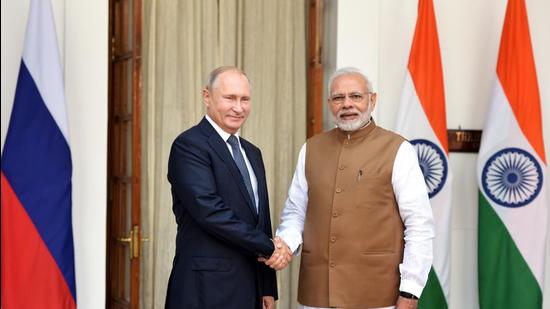The centrality of the Arctic in the India-Russia partnership
For Russia, it showcases its reliability as far as difficult geography is concerned, while for India, the partnership expresses a confident country
While defence deals and military technical agreements will be high on Russian President Vladimir Putin’s agenda during his visit to India next week, there is a need to pay attention to the drivers of the future bilateral trajectory. Russia’s Arctic and its Far East region offer an area of convergence, and the potential to scale up relations. New Delhi’s year-old draft Arctic Policy with its 5+5 mission and pillars outlines India’s interests, “to enhance sustainable and mutually beneficial cooperation between India and the Arctic region”.

For Russia, the Arctic is its natural coast-to-coast sphere and has outsized importance. Long before St Petersburg was established on the shores of the Baltic in the 18th century as a “window onto Europe”, Russia set up its base in Okhotsk in 1650. Today, the Russian Federation, from the east to west, has the longest Arctic coastline with 2.5 million people, living above the Arctic Circle. The region accounts for 80% of Russia’s known natural gas reserves and contributes 12% of its Gross Domestic Product.
In recent years, Russia’s focus on the Arctic has grown, as has that of other North Atlantic Treaty Organization (NATO) states with Arctic shores — Canada, Denmark, Iceland, Norway and the United States (US). Russia’s National Security Strategy in 2015 (updated in 2021) had a non-military triple approach to the Arctic — resource exploitation; infrastructure development; and international cooperation. This forms the basis of Russia’s long-term Arctic policy till 2035.
Contrary to views about Russia’s muscular Arctic approach, defence development and military matters have actually been de-emphasised. Even Russia’s Armaments Plan (2018-2027) de-emphasises the High North. Having possibly achieved its optimum military presence in the Arctic, Russia is now signalling that the Arctic and the Far East region is a zone of cooperation and development.
As Russia looks to expand its energy export from the Arctic shelf and the shores of the Pechora and Okhotsk Seas to Asia, which it outlines as a “strategic resource base”, India is a “special and privileged partner”. Energy ties with Russia are crucial for India’s transition from fossil fuels to cleaner sources of energy. As a win-win outcome, India should work the mechanisms to enhance infrastructure and energy development plans in the Russian Far East as emphasised at the Sixth Eastern Economic Forum in Vladivostok.
With Russia developing the northern sea route (NSR) as a critical “national transport corridor”, India can project its hydrographic capacity. As a member of the Hydrographic Commission on Antarctica, India co-produced with Russia the Bathymetric chart. India’s experience can add value to the mapping of Arctic routes.
The shipping activities in the NSR and the off-shore energy projects will require skilled seafarers and a trained workforce. Interestingly, India ranks third globally in providing seafarers in the maritime sector. Tie-ups with Russian universities offering seafaring courses in polar waters can skill the Indian youth in the maritime industry. As economic opportunities increases, the Russian Arctic could become a migrant worker destination.
Connectivity is another driver in the strategic partnership with underlying commercial advantages and overall economic development. Parallel to the multimodal International North-South Transport Corridor, the proposed Chennai–Vladivostok Maritime Corridor (CVMC) to connect the eastern Indian ports with Vladivostok, Vostochny and Olga on the east coast of Russia will act as an extension to the NSR, which otherwise has limited benefit for India both in terms of shipping distance and travel time. It will also sharpen India’s strategic intent in the South China Sea and the Indo-Pacific region, with a naval presence securing its energy and trade shipments from the Russian Far East.
The Arctic and the Far East region give unmatched complementarities to both countries. For Russia, it showcases its reliability as far as difficult geography is concerned, while for India, the partnership expresses a confident country willing to explore creative diplomatic pathways for its development.
Uttam Sinha works at the Manohar Parrikar Institute for Defence Studies and Analyses
The views expressed are personal
Continue reading with HT Premium Subscription




